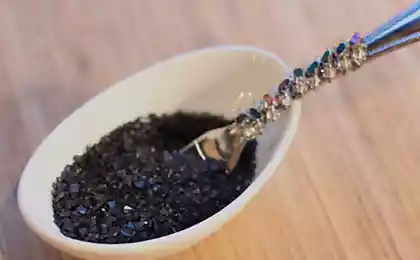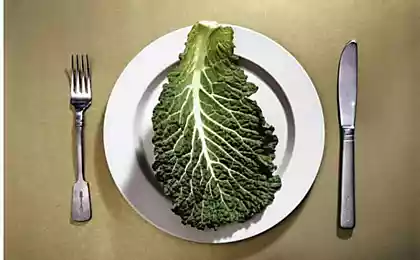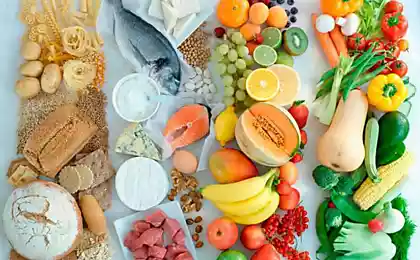306
People with high blood pressure: a salt-free diet! Diet table number 7.
The name “salt-free diet” scares away many, because everyone immediately presents tasteless food and fresh dishes, but this is just not a mandatory item. And salt is not completely excluded from the diet. Sodium plays an important role in the regulation of many life processes, especially in maintaining the balance of acids in the body and maintaining water levels.

DepositPhotos
This diet is useful not only for weight loss, it is rather therapeutic and necessary for people suffering from certain diseases. Today's edition. "Site" Tell me why. salt-free It is so useful as to observe it without harming the body, and to whom it is simply necessary.
According to statistics from the International Organization of Medicine, every second person eats salted food. Consumption of table salt is three times higher than normal. Every day we should consume no more than 5 grams of salt, and we eat more than 15. Many products can be oversalted, although we do not notice this: cheeses, smoked foods, canned food. Conventional products already contain sodium. This means that salt enters our bodies even if we do not salt our food.

DepositPhotos
Salt-free diet, or treatment table number 7, is a gentle diet. It should be adhered to by people with heart and vascular diseases, decompensation and in cases where fluid retention occurs in the body. It is also recommended for people with high blood pressure, as well as for kidney diseases.
The body of a healthy person is able to cope with excess sodium, but with all these diseases, salt is not excreted, trapping water. Because of this, swelling appears and the risk of developing hypertension increases.

Let's understand the intricacies of the treatment table No. 7. Most often it is prescribed to people suffering from kidney diseases (chronic nephritis). With this diet, you need to cook food in boiled or baked form. Calorie diet should be at least 3,500 kcal per day. It is advisable to take food 4-6 times a day.
All food is prepared without salt. If only kidney problems, then its amount should not exceed 2-3 g per day. At high pressure, food should be cooked without salt at all. It is also worth limiting the use of foods high in sodium. In addition, it is necessary to limit the consumption of protein.
Prohibited products
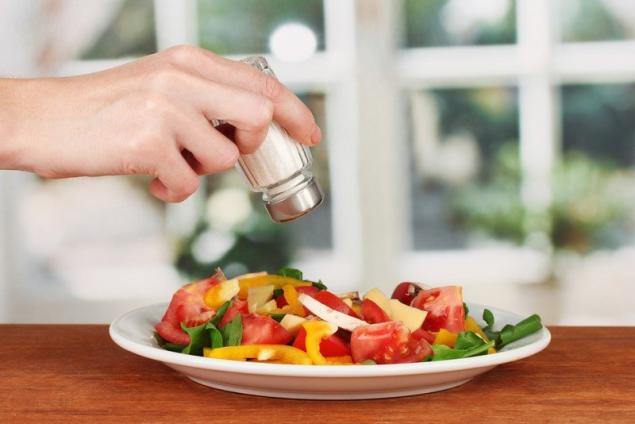
Many do not imagine food without salt and think that it is completely tasteless, but it is not. Improvement of taste can be achieved through the correct selection of products and cooking technology. Without salt, for example, potatoes and buckwheat porridge are good. Almost all vegetables can be safely eaten without salt. This helps to feel the real taste of the products.
To smooth out the lack of salt, you can use spices: coriander, a mixture of peppers, spicy herbs, cumin and many others. You can also compensate for salt with a sour taste, adding sour milk or sour cream to food. You can also season dishes with a majoran, bay leaf or dill.

DepositPhotos
With this diet, you can use carbohydrates without restrictions: pasta, bread, casseroles, rice, but all this should be without salt. Baking can be cooked yourself, but then it is better not to add soda or baking powder, because they also contain sodium. It is better to use vegetable oils from fats.
In fact, cooking for a salt-free diet is quite simple if you adjust. And now the promised menu for the week.
Salt-free diet menu
Most often, doctors advise to follow a diet for 14 days. You can switch to such a diet on a permanent basis, but you should also not zeal. Lack of salt can harm the body. Thanks to a salt-free diet, you will be able to get rid of a couple of extra pounds, as well as edema, restore water-salt balance and improve health.
Everything needs to be approached wisely, especially when choosing a diet. Be sure to consult your doctor to avoid unforeseen health problems.
Would you like to know the recipes for a salt-free diet? If yes, let us know in the comments!

DepositPhotos
This diet is useful not only for weight loss, it is rather therapeutic and necessary for people suffering from certain diseases. Today's edition. "Site" Tell me why. salt-free It is so useful as to observe it without harming the body, and to whom it is simply necessary.
According to statistics from the International Organization of Medicine, every second person eats salted food. Consumption of table salt is three times higher than normal. Every day we should consume no more than 5 grams of salt, and we eat more than 15. Many products can be oversalted, although we do not notice this: cheeses, smoked foods, canned food. Conventional products already contain sodium. This means that salt enters our bodies even if we do not salt our food.

DepositPhotos
Salt-free diet, or treatment table number 7, is a gentle diet. It should be adhered to by people with heart and vascular diseases, decompensation and in cases where fluid retention occurs in the body. It is also recommended for people with high blood pressure, as well as for kidney diseases.
The body of a healthy person is able to cope with excess sodium, but with all these diseases, salt is not excreted, trapping water. Because of this, swelling appears and the risk of developing hypertension increases.

Let's understand the intricacies of the treatment table No. 7. Most often it is prescribed to people suffering from kidney diseases (chronic nephritis). With this diet, you need to cook food in boiled or baked form. Calorie diet should be at least 3,500 kcal per day. It is advisable to take food 4-6 times a day.
All food is prepared without salt. If only kidney problems, then its amount should not exceed 2-3 g per day. At high pressure, food should be cooked without salt at all. It is also worth limiting the use of foods high in sodium. In addition, it is necessary to limit the consumption of protein.
Prohibited products
- Meat, fish and mushroom broths.
- Fatty varieties of meat and poultry, sausages, sausages, smoked meats, canned food.
- Fatty fish, salted and smoked fish, caviar, canned food.
- Cheese, legumes, chocolate.
- Onions, garlic, radish, sorrel, spinach, pickled and sauerkraut.
- Spicy, fatty snacks, sauces, mustard, horseradish.
- Strong coffee, cocoa and mineral water.

Many do not imagine food without salt and think that it is completely tasteless, but it is not. Improvement of taste can be achieved through the correct selection of products and cooking technology. Without salt, for example, potatoes and buckwheat porridge are good. Almost all vegetables can be safely eaten without salt. This helps to feel the real taste of the products.
To smooth out the lack of salt, you can use spices: coriander, a mixture of peppers, spicy herbs, cumin and many others. You can also compensate for salt with a sour taste, adding sour milk or sour cream to food. You can also season dishes with a majoran, bay leaf or dill.

DepositPhotos
With this diet, you can use carbohydrates without restrictions: pasta, bread, casseroles, rice, but all this should be without salt. Baking can be cooked yourself, but then it is better not to add soda or baking powder, because they also contain sodium. It is better to use vegetable oils from fats.
In fact, cooking for a salt-free diet is quite simple if you adjust. And now the promised menu for the week.
Salt-free diet menu
- Day 1st
Breakfast: coffee with milk, cottage cheese, saltless bread, vegetable fat (margarine).
Second breakfast: baked apple.
Lunch: potato soup or baked potatoes, roasted from onions, tomato salad, cake "Napoleon".
Afternoon: rosehip broth, saltless bread, jam.
Dinner: baked potatoes, leafy salad with yogurt, cottage cheese with fruit.
DepositPhotos - Day 2.
Breakfast: coffee with milk, cottage cheese, saltless bread, vegetable fat (margarine).
Second breakfast: an orange or an apple.
Lunch: dill soup with potatoes, chicken baked with cauliflower, nut cake.
Afternoon: tea with milk, muffin.
Dinner: charlotte with apples and cottage cheese, tea. 175280
DepositPhotos - Day 3.
Breakfast: broth of rosehip, 1 egg, saltless bread, margarine.
Second breakfast: strawberries or tomatoes, green sweet peppers, unsalted bread.
Lunch: vegetable borscht, cream buns.
Afternoon: coffee with milk, unsalted bread.
Dinner: grilled chicken, rice, fruit salad.
DepositPhotos - Day 4.
Breakfast: coffee with milk, cottage cheese, saltless bread, jam.
Second breakfast: grated carrots with apple and lemon.
Lunch: fruit soup, roasted beef, potatoes, beet salad.
Afternoon: strawberries with whipped cream.
Dinner: vegetable stew, compote, apple roll.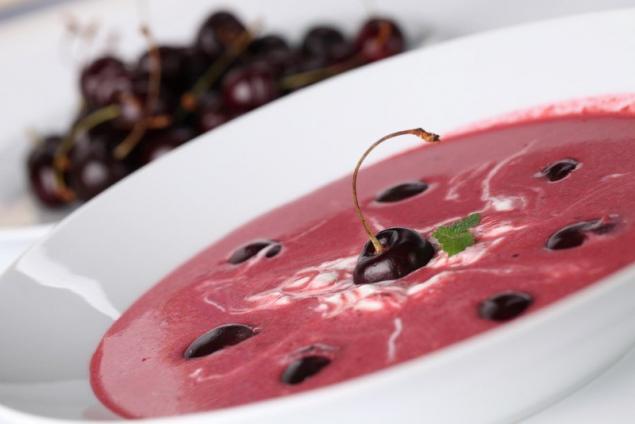
DepositPhotos - Day 5.
Breakfast: tea with milk, saltless bread, margarine.
Second breakfast: cottage cheese.
Lunch: leek soup, fruit pretzels in bread.
Afternoon: milk, bread without salt, butter, jam.
Dinner: beef with vegetables, rice.
DepositPhotos - Day 6th
Breakfast: coffee with milk, cottage cheese, bread, jam.
Second breakfast: fruit.
Lunch: tomato soup with rice, beef, celery salad with apple, potatoes with cumin, fruit jelly.
Afternoon: yogurt with jam.
Dinner: Rice casserole with raspberry syrup.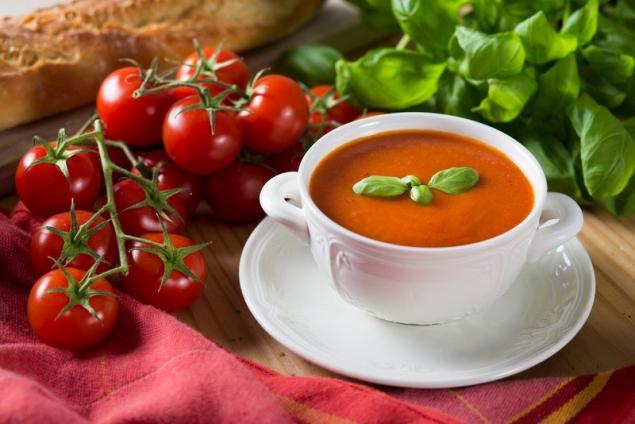
DepositPhotos - Day 7.
Breakfast: tea with lemon, bread, margarine, honey.
Second breakfast: cocoa, muffin.
Lunch: cauliflower soup, cutout with lingonberry and potatoes, nut cake.
Afternoon: fruit and compote.
Dinner: Casserole of cauliflower, but without salt, salad.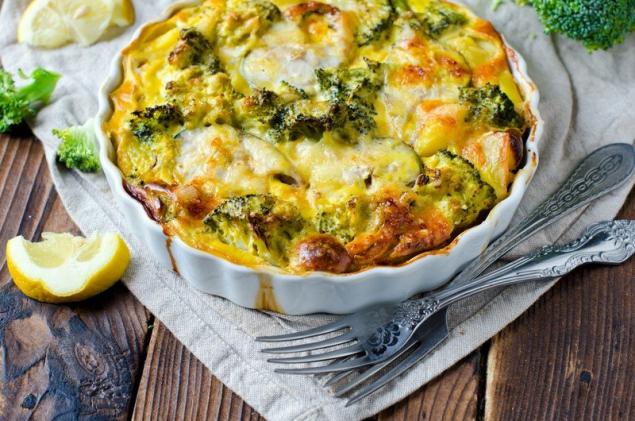
DepositPhotos
Most often, doctors advise to follow a diet for 14 days. You can switch to such a diet on a permanent basis, but you should also not zeal. Lack of salt can harm the body. Thanks to a salt-free diet, you will be able to get rid of a couple of extra pounds, as well as edema, restore water-salt balance and improve health.
Everything needs to be approached wisely, especially when choosing a diet. Be sure to consult your doctor to avoid unforeseen health problems.
Would you like to know the recipes for a salt-free diet? If yes, let us know in the comments!


















